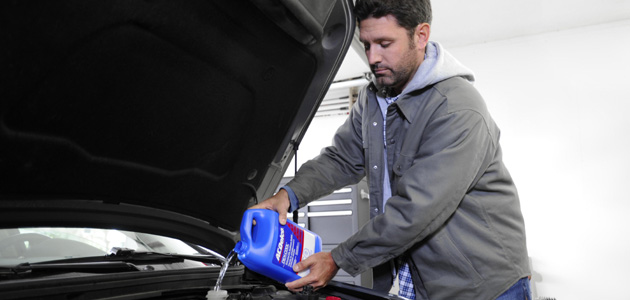
Let’s face it, summertime is drive time. It doesn’t matter whether your customer has a soft top, estate car or saloon, the appeal of sunny skies and an open road is all it takes to get most drivers out onto the road. Even the ongoing rising cost of motoring has done little to dampen the spirits of those who relish the opportunity to revel in the enjoyment of summertime driving.
But before hitting the road, you should encourage your customers to stop and think for a moment. What steps can they take to keep the family and myself safe, whilst hopefully saving money in the process? Extreme heat and long drives can be tough on cars. They are, after all, made up of many mechanical components that can and sometimes do fail.
With this in mind, ACDelco has highlighted its Top Ten Tips to pass onto your customers to help keep them, and their car, cool in what will (hopefully) be the long, hot summer months:
10: Tyres Really Matter
Whilst tyres are what keep our vehicle in touch with the road, they remain a commonly overlooked part of the car by most drivers. Indeed according to some motoring organisations, it is believed that as low as one in 10 drivers actually regularly check their tyre pressure! This is a worry, particularly when almost seven out of 10 think to wash their cars regularly. The truth is stark – underinflated, overinflated, worn or misaligned tires can be extremely dangerous, particularly in hot summer weather.
So to stay safe, the answer is a simple one – make sure tyre pressure and tread checks are undertaken.
9: Change Oil and Oil Filter
Quite simply, oil is the lifeblood of a car, so neglect it at your peril. It keeps engine parts that operate consistently under stress lubricated, smooth and cool. And whilst it is important to check oil levels throughout the year, it is during heavy driving in the summer when an engine is more likely to overheat.
Checking the oil level is a really simple process. All you have to do is make sure the car is on a level surface, and after shutting off the engine, open the bonnet hood and locate the oil dipstick. If it is low, it can simply be topped up or changed completely. Colourwise, the oil should look brownish yellow and clean on the stick. If it is a dark colour or it appears contaminated with dirt and grime, both an oil and oil filter change is on the cards.
8: Take The Car Out Of Hibernation
Just as it is important to make sure the car is winterised properly, , it is equally important to de-winterise for the summer months. If the car hasn’t been driven very much in the winter, it is imperative that first and foremost fluid levels are checked – coolant, transmission, differential, power steering and brake. The oil should also be changed, and the battery checked, as this may need recharging or, in certain instances, replacing.
Another important consideration is to spend some time cleaning the underside of the car. Salt used to melt snow and ice on roads is very corrosive on metal.
7: Check Hoses and Belts
Just as important as it is for drivers and their passengers to keep cool, the same applies to the engine. And whilst we are going to talk about the radiator and coolant levels soon, the need to check the hoses and belts should not be underestimated. The hoses connected to the radiator help pump coolant to and from the engine block, and the belts run the fan that helps cool the system further. If the hoses crack or the belts snap, the radiator will quickly overheat, possibly leaving you stranded roadside.
Here it is all about checking hoses for cracks, leaks and loose connections. Belts can also be visually checked for cracks and damage. Take note if the belt looks excessively slick or smooth.
6: Air Filter Change Is A Must
What a lot of drivers fail to realise is that a clogged or inefficient air filter can radically lower fuel consumption, perhaps in some instances by up to 10%. Surely then it’s worth replacing after the winter months, as this is the period where it can get clogged with salt and other types of debris.
But how do you know when to change your air filter? The best way to know is to take it out and give it a quick inspection. That said, the recommended interval is every 12,000 miles (19,312 kilometers), but such intervals can be affected by the particular road and air conditions.

5: Replace Windscreen Wipers
Okay, so why should you change the wiper blades at the time of year where surely precipitation for most of us is going to be at a minimum? The answer is two-fold: a) the summertime is notorious for sudden, violent storms, when buckets of water can often beat against the windscreen. In such circumstances, wipers that really work are essential. This is even more important at night, when a rainstorm can decrease visibility to 15 or 20 feet in front of your vehicle.
b) Winter driving is tough on the wipers themselves, with ice, snow, salt and extreme temperatures causing cracks and tears that in all instances lower their effectiveness. So if the wipers are leaving visible streaks or take several passes to clear away light rain, they need to be replaced.
4: Check The Brakes
It is a well-known fact that brakes are the single most important safety feature on the car, so why would anyone put themselves or their family at risk this summer by riding around on worn or potentially faulty brakes?
Should the customer experience any of the following, it is wise to advise them to get their brakes checked over by the workshop as soon as possible.
- The brake pedal becomes very soft and mushy
- The brake pedal becomes very hard and resistant
- The brake pedal rests too low or too high
- Indication or warning lights appear on the dashboard
- A loud and constant scraping or grinding sounds come from the brakes
3: Check Coolant Levels And The Radiator
Whilst cars are designed to run hot, there is a limit. A normal combustion engine, for example, is most efficient at around 200 degrees Fahrenheit (93 degrees Celsius). But what happens if an engine is allowed to get too hot? Under such circumstances, moving metal parts can actually start to melt and fuse together, causing a variety of internal problems for your engine.
Luckily, all modern cars have an ingenious system with which they use to remain cool called, quite simply, the cooling system. This is made up of a resourceful chemical coolant, called antifreeze, and a series of pumps, hoses, thermostats and fans that all interact to keep the car running at its optimal temperature. The summertime is tough on cooling systems, so here again it’s all about checking coolant levels.
2: Keep Charge Of The Battery
Whilst the wintertime is notorious for the plaque of the dead battery and early morning jumpstarts, the truth is that hot weather can be even tougher on such a critical automotive component. The summer heat can speed up the chemical reaction inside a battery, causing it to overcharge. This can dramatically shorten lifespan of the battery, whilst also damaging it by evaporating internal battery fluid.
So the best way to keep the battery running smoothly is to keep it clean. Regularly detach the battery cables and wipe off the terminals. Make sure the battery is strapped down tightly and that all connections are secure. If it is suspected that the battery is being overcharged or isn’t holding a charge well, a workshop should be called in to carry out a quick inspection.
1: Make Air Conditioning The Number One Priority
Have you ever suffered from a loss of air conditioning on a boiling hot summer’s day? Well if you have, then you’ll appreciate how uncomfortable and unbearable the cabin temperature can become in such a short period of time. If you haven’t, then you don’t want to. The best way to tell if the air conditioner has a problem is if it can’t generate or maintain air temperatures that are 50 degrees Fahrenheit (10 degrees Celsius) below the ambient outside air temperature.
The most common cause of a malfunctioning air conditioning unit is a low level of refrigerant. This could be caused by a leak somewhere in the system, and since modern air-conditioning systems are complicated creatures, it is best to have a professional check out the problem.









